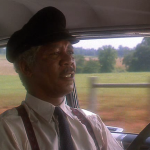Mr. Smith Goes to Washington Review
It easy to understand how some people can view Mr. Smith Goes to Washington as overly idealistic and cheesy. It is in so many ways. But despite that (or perhaps because of it), most regard it as an American classic and one of the finest films to come out of the 1930s. The film is a testament to individualism and the American spirit. The courage of the title character sweeps you up, and his ultimate success (it’s a Frank Capra film; nobody should be surprised that the hero succeeds) makes for a truly magical movie experience.
Jefferson Smith (a terrific James Stewart) is a Boy Scout troop leader and local hero in an unnamed western state (presumably Montana, since the film is based on a story called “The Man from Montanaâ€). When one of the state’s senators dies, it’s up to the governor (Guy Kibbee) to appoint his replacement. James Taylor, the town’s boss who’s known for corrupting its politicians, has a vested interest in who the governor selects. He and the state’s other senator, Joe Paine (Claude Rains), have purchased a great deal of land under false names and intend to sell it to the government to build a dam. The new senator must be a stooge, someone who won’t ask any questions about their plan. But the people know of Taylor’s corruption and pressure the governor to go against Taylor and choose an honest man. The governor decides (with the help of a tricky coin) to go with his children’s choice, Smith.
From there the plot follows a familiar trajectory. There’s nothing challenging here—nothing that requires any deep thought. It’s just good, old-fashioned storytelling. When Smith discovers the corrupt plan, he tries to stand up to Taylor and Paine but faces damning accusations. With his character and plans for an outdoor camp on the line, Smith stands up to the entire Senate and filibusters his own impeachment proceedings.
No doubt the biggest strength of Mr. Smith Goes to Washington is its sense of patriotism. There’s nothing subtle about it, but because it is so over the top, you can’t deny its effectiveness. One of the best sequences in the film is when Smith first arrives in Washington. He is so star-struck that he sneaks away from his entourage and hops a sightseeing bus. And the David v. Goliath battle between Smith and the entire Senate is as quintessentially American as it gets.
The film is also helped by the tremendous performances of the two leads. Stewart does a great job portraying Smith as a wide-eyed idealist who transforms into a scorned one-man army. In the end, Smith has no choice but to stand up and protect the values he believes in (by talking and talking and talking). His work is matched by that of Jean Arthur as Saunders, Smith’s spunky, charismatic secretary. She teaches Smith how to play the Washington game. In one masterful back-and-forth, Saunders, who hasn’t yet come around to Smith’s charm, explains to him how hard it is to get a bill passed, while Smith seems more determined with every obstacle she throws at him. Able supporting work is added by Rains as the crafty Senator Paine, Thomas Mitchell (who won a supporting actor Oscar the same year for his work in John Ford’s Stagecoach) as a helpful reporter, and Edward Arnold as the slimy Jim Taylor.
Mr. Smith is a magical experience. The characters are fully realized, and the message resonates strongly. It’s a story that’s predictable, and definitely not restrained, but incredibly powerful during a time when Congress’ approval ratings have slipped to all-time lows. It makes us wish we had a few more Mr. Smiths in Washington today.















